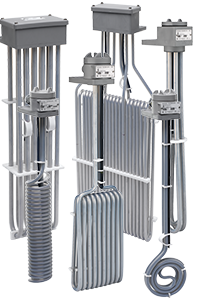Click below to learn why electroless nickel platers like Bob are making the switch to One Plate - Single Component Electroless Nickel.
Traditionally, most chrome baths use lead anodes. When we think of lead anodes, we usually just think about the lead part, but in fact the lead anodes that are used are never made of pure lead. Chromic acid in the bath eats away at pure lead, especially when there is no current. Pure lead is also quite soft, does not hold its shape very well and sags under its own weight. This is why lead is alloyed with other metals in order to give it specific properties. Various amounts of antimony, tin and silver are added to the lead depending upon the application.
Antimony: Provides hardness, rigidity and resistance to curling or sagging and is used whenever strength is required. High antimony contents, however, tend to produce excessive surface scale and a less than optimum trivalent control. Antimony has a density of 0.24 lbs. per cubic inch and a melting temperature of 1170 degrees F.
Tin: Provides improved corrosion resistance and conductivity, reduces surface scaling and improves trivalent control. Used primarily in high fluoride baths. Tin has a density of 0.26 lbs. per cubic inch and a melting temperature of 450 degrees F.
Silver: A small amount of silver (0.5 - 1%) greatly extends the corrosion resistance and increases the conductivity. Due to the additional cost, this is used only where an extended anode life is required such as in very high fluoride baths.
C. P. Grade Lead: CP grade lead (99.9 % chemically pure) is the basic material that is used to make the various alloys. CP lead has a density of 0.41 lbs. per cubic inch and a melting temperature of 620 degrees F.
Lead Alloys: The anode materials are purchased from a smelter already alloyed per specification. These materials are available in ingots, cast mats, rolled sheet & bars, extruded pipe and extruded rods or wire in various sizes. Extruded and rolled forms are much denser than cast materials are and will therefore hold up much longer and are better suited for large anodes or ones that need to last for long periods of time.
It is good practice to standardize alloys and use only one type per bath. If several alloys are used then the each type should be marked so they are not accidentally mixed. Lead alloys should never be obtained from a scrap dealer as the quality is unknown. Most lead alloys used for chrome plating have a density of around 0.40 lbs. per cubic inch and a melting point of 580 – 600 degrees F.
6% antimony - 94% lead: This is a very common alloy that is used for a majority of chrome plating anodes. The antimony provides both hardness and rigidity and is particularly well suited for large or heavy anodes. The surface film from this alloy provides reasonable control of the trivalent, but the scaling is heavier than if tin were present.
7% tin – 93% lead: Used in all type baths including high fluoride solutions. This alloy is softer than 6/94 is and may sag if too heavy or too large. This alloy has an improved peroxide surface film for better trivalent control and reduced scaling.
2% tin – 4% antimony – 94% lead: This alloy provides a combination of improved rigidity and corrosion resistance. It has a better surface film than 6/94 does, but not quite as good as the 7/93 alloy is. It is used where a combination of optimum strength, resistance to distortion and surface film is needed.
0.5% silver – 4% tin – 2% antimony – 93.5% lead: The addition of a small amount of silver greatly improves the surface film and increases the corrosion resistance. The silver content is typically 0.5%, although it can be as high as 1% for even greater benefit. This alloy typically lasts 2-3 times longer than the others do. Obviously, the cost of the silver must be weighed against the value of the additional benefits obtained. This alloy is used primarily in very high fluoride baths.
A fire on the plating lines is always a disaster, but one that can be avoided by taking the proper precautions. One of the most common causes of these fires is electrical heaters, which often set fire to plastic tanks because of a drop in the solution level.
A common misconception is that the thermostat will stop the heater. However, this is not the case. Why doesn't the thermostat stop the heater? It’s because the thermostat relies on the liquid to transfer heat from the heater to the probe/sensor. If there is a sudden loss of liquid and the sensor is no longer covered by the liquid, then no heat is transferred. The thermostat detects this as a drop in temperature and keeps the heater operating. With no liquid to transfer heat away from the heating element it begins to overheat and sets the plastic tank on fire.
Very few plating tanks have low level devices controlling their heaters to detect a drop in solution. We can provide the right thermal protection fuses for your heaters. Our over-temp protectors utilize a heat sensitive fuse to detect overheat conditions. The protector, which is placed inside a thermowell, is positioned in contact with the heater sheath and will cut power to the heater in the event of low liquid level. When combined with the technology of our liquid level sensor, you can further eliminate this danger.
We have an impressive catalog of both heaters and controllers at Plating International, so reach out to one of our representatives for a quote today, and find out what heater set-up best suits your needs! #surfacetreatment #heaters #worksafety #firesafety #OSHA



